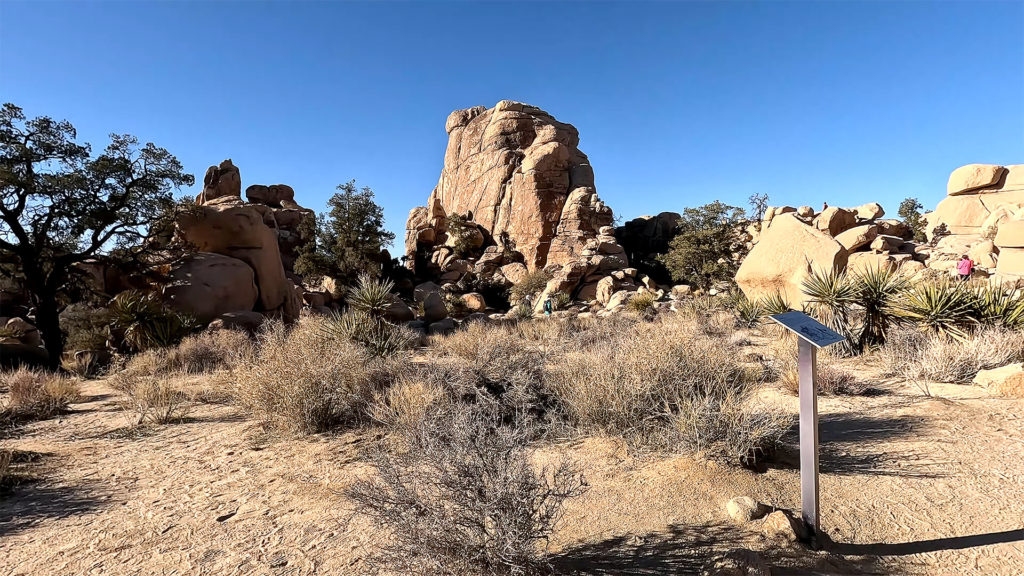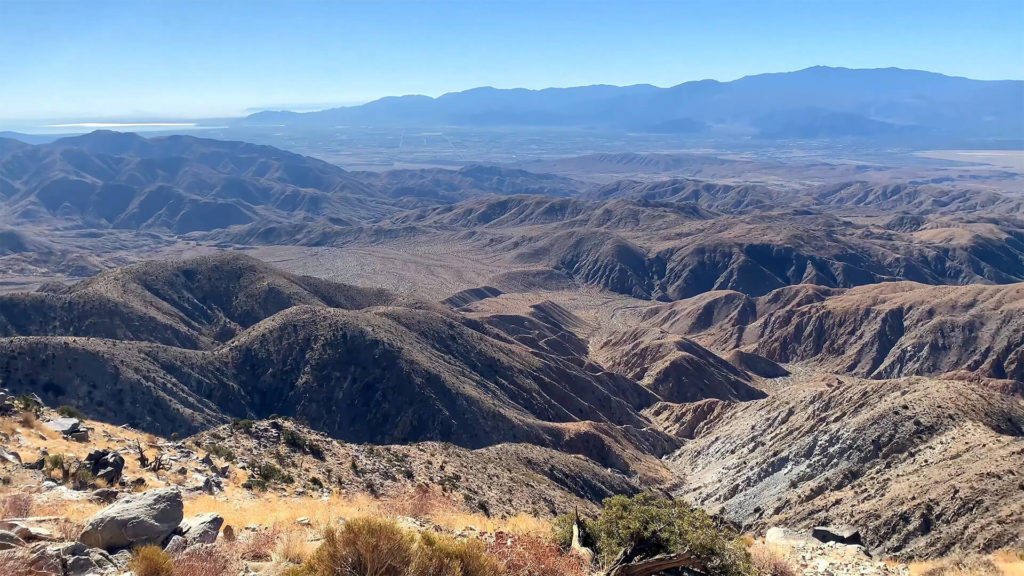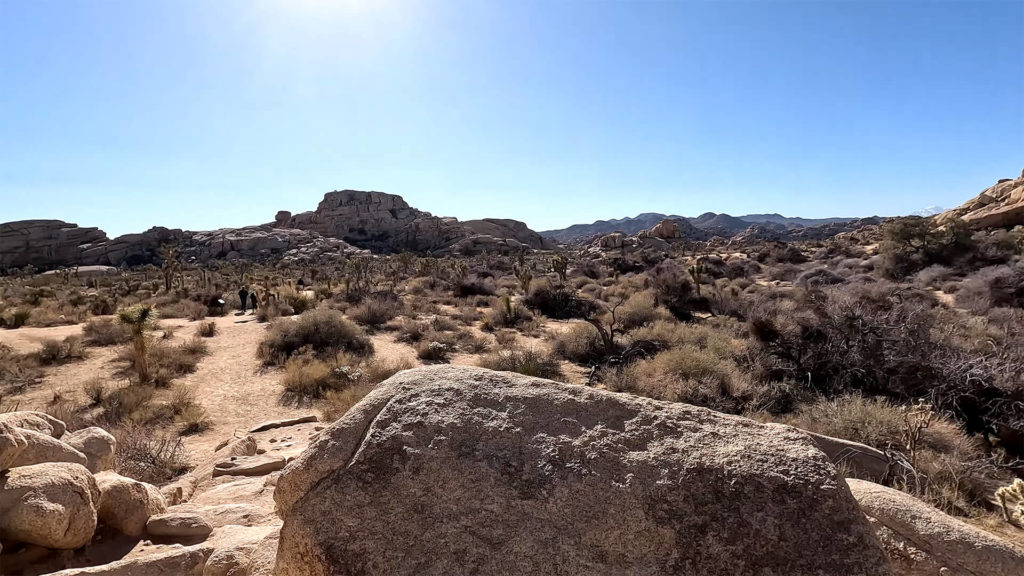Joshua Tree National Park is a mesmerizing desert landscape that captivates visitors with its enchanting Joshua trees, colossal granite boulders, and picturesque mountains. Stepping into this park feels like entering a world straight out of a children’s storybook, evoking a sense of wonder and spirituality. Whether you enjoy hiking, rock climbing, camping, or simply immersing yourself in the tranquility of the desert, there is something for everyone in this extraordinary national park.
1. Embark on the Hidden Valley Nature Trail & Day Use Area

The Hidden Valley Nature Trail is one of the most accessible and visually stunning areas of Joshua Tree National Park. This delightful one-mile loop trail takes you through a large bowl surrounded by towering rock walls. It is believed that this secluded valley was once used by cattle rustlers to conceal their herds. The trail offers a relatively easy and scenic hike, showcasing the park’s unique rock formations. Don’t miss the Great Burrito, a massive monolith that serves as a popular climbing spot.
The Hidden Valley picnic area, located across from the trailhead, is a picturesque spot adorned with majestic Joshua trees and massive boulders. It’s a perfect place to enjoy a picnic surrounded by the beauty of nature. From the picnic area, a short trail leads to the back side of the boulders, where you’ll discover a magical wonderland of rocks and trees, providing endless opportunities for photography.
2. Experience the Breathtaking Views from Keys View

A visit to Keys View is an absolute must when exploring Joshua Tree National Park. Situated at an elevation of over 5,000 feet, this lookout point offers sweeping panoramic views of the Coachella Valley. On clear days, you can see the San Andreas fault line, Palm Springs, the Salton Sea, and even Mexico. As you ascend to Keys View, the temperature drops and the landscape undergoes a dramatic transformation, immersing you in a whole new world.
Take a moment to absorb the stunning vistas and orient yourself with the surrounding geography. Keys View is a perfect spot for sunrise or sunset viewing, providing an awe-inspiring experience you won’t soon forget.
3. Wander Along the Barker Dam Nature Trail

If you have limited time and can only choose one trail in Joshua Tree National Park, make it the Barker Dam Nature Trail. This 1.3-mile loop trail offers a fantastic showcase of the park’s iconic Joshua trees, unique rock formations, and a small water feature that often attracts a variety of birds.
At the far end of the loop, you’ll find the remnants of a water tank left behind by cattle ranchers who once inhabited the area. Many hikers turn back at this point, but venturing further into the loop reveals even more breathtaking scenery, including the park’s largest trees and captivating landscapes beyond the dam.
4. Immerse Yourself in the Unique Camping Experience
Camping in Joshua Tree National Park is an extraordinary adventure that allows you to fully immerse yourself in the desert’s natural beauty. Picture yourself camping among the iconic Joshua trees, surrounded by otherworldly rock formations. The park offers several stunning campgrounds, each with its own distinct charm and character, providing an unforgettable experience under the starry night sky.
For a first-come, first-served camping experience, Hidden Valley Campground is an excellent choice. However, if you prefer the security of a reservation, Jumbo Rocks is your best option. Both campgrounds are conveniently located near major attractions, ensuring easy access to all the wonders of the park. Spring and fall are the ideal seasons for camping, as the weather is pleasant, and the days are filled with warm sunshine.
5. Marvel at the Cholla Cactus Garden
Nature enthusiasts will be captivated by the Cholla Cactus Garden, an awe-inspiring sight within Joshua Tree National Park. Here, you’ll find thousands of densely packed cholla cacti stretching across the desert floor, creating a unique and mesmerizing landscape. Unlike other areas of the park where cacti are scattered among various vegetation, this natural garden is exclusively adorned with cholla cacti.
In the early morning or late afternoon light, the backlit needles of the cholla cacti seem to glow, while the distant mountains provide a stunning backdrop. A leisurely walk along the easy, level trail will lead you through this magical place, offering countless opportunities for remarkable photographs. The Cholla Cactus Garden is located on the road to Cottonwood Spring, beyond Belle and White Tank campgrounds.
6. Discover the Fascinating Skull Rock
Skull Rock is an iconic feature of Joshua Tree National Park, showcasing the park’s surreal and almost otherworldly landscape. As you approach this roadside stop, you’ll immediately notice the skull-like shape peering out from the scattered boulders. The area surrounding Skull Rock is equally intriguing, with vast expanses of rolling rock piles, perfect for leisurely walks or light scrambling.
Trails crisscross the area, but many visitors prefer to explore freely, finding elevated spots for breathtaking views, relaxing on the sun-soaked slabs of rock, or simply taking a moment to appreciate the surreal surroundings. Across the street from Skull Rock, a 1.7-mile hiking trail leads through rocky terrain and shrubby vegetation, with scattered Joshua trees adding to the allure of the landscape.
7. Conquer the Rock Climbing and Bouldering Challenges
Rock climbing and bouldering enthusiasts flock to Joshua Tree National Park to experience its world-class climbing opportunities. With approximately 8,000 climbing routes and numerous climbing formations, the park offers endless challenges for climbers of all skill levels. Information pamphlets and maps are available at the visitor centers to assist you in planning your climbing adventures.
The Hidden Valley area and neighboring sites at the park’s west end are popular hotspots for climbers. Winter is the prime climbing season, as other renowned climbing destinations like Yosemite are usually out of season during this time. As a result, campsites in this area fill up quickly, so plan accordingly, especially if you’re visiting in February or March.
8. Conquer the Ryan Mountain Hike
The Ryan Mountain hike is a rewarding trek that offers breathtaking views from the summit. Although the initial ascent may seem daunting, the real reward awaits those who persevere. The trail stretches for three miles, featuring an elevation gain of 1,000 feet. While the trail itself may lack shade and excitement as it traverses a barren hillside, the views from the summit, at an elevation of 5,457 feet, make the effort worthwhile.
Prepare for an exposed hike and ensure you have plenty of water and sun protection. Once you reach the summit, take a moment to marvel at the 360-degree panorama that unfolds before you, allowing you to truly appreciate the grandeur of Joshua Tree National Park.
9. Step Back in Time with a Guided Tour of Keys Ranch
Explore the fascinating history of Joshua Tree National Park with a guided tour of Keys Ranch. This former homestead and ranch, belonging to William F. Keys, provides a glimpse into the challenges and triumphs of early settlers in the region. The property, including the house, schoolhouse, store, and workshop, is a designated National Historic Register Site, and access is only available through ranger-led tours.
These informative tours run seasonally, primarily during the winter and spring months. They offer valuable insights into the life of William F. Keys and the resourcefulness required to survive in this unforgiving desert environment. Remember to make reservations in advance, as tours have limited availability. The 90-minute tour involves a half-mile walk, providing a captivating journey into the past.
10. Experience the Oasis at Cottonwood Spring
Cottonwood Spring Oasis is a true gem within Joshua Tree National Park. This permanent spring, an unusual sight in the desert, boasts a flow of approximately 500 gallons per day. The spring’s origins can be traced back to an earthquake that occurred many years ago. Throughout history, it has served as a vital water source for Native Americans, miners, and prospectors.
Visitors to Cottonwood Spring can explore the remnants of old gold processing equipment and concrete ruins, remnants of the area’s mining past. The oasis is also a haven for wildlife, attracting a variety of birds due to its reliable water source, shade, and trees. Keep an eye out for Gambel’s quail, hummingbirds, bushtits, and the distinctive titmouse with its pointed crown. Cottonwood Spring provides a peaceful and refreshing retreat within the arid desert landscape.
11. Marvel at the Natural Arch on the Arch Rock Trail
The Arch Rock Trail offers a captivating hiking experience with minimal effort. This 1.4-mile lollipop trail treats hikers to ever-changing scenery throughout their journey. About halfway along the trail, you’ll encounter the arch, a natural wonder nestled among the peculiar rock formations that define Joshua Tree National Park. Although the arch may appear modest compared to those found in other national parks, its surroundings make it an extraordinary sight.
The trail’s gentle elevation gain of 100 feet makes it accessible to most hikers, while still providing a sense of accomplishment. The Arch Rock Trail is a popular choice among visitors, so expect to encounter fellow nature enthusiasts along the way.
12. Witness the Spectacle of Wildflowers in Spring
Spring brings a burst of vibrant colors to the desert, and Joshua Tree National Park is no exception. The park’s namesake Joshua trees bloom during this season, accompanied by a plethora of wildflowers, shrubs, and cacti. Each week brings a new wave of blooms, creating a kaleidoscope of colors throughout the park.
For an unforgettable wildflower experience, head to the area near Cottonwood Spring and the road leading to Interstate 10. Here, you’ll find a breathtaking variety of spring wildflowers concentrated in large patches. The smaller Joshua trees in this area showcase blooms at eye level, allowing for a more intimate and immersive viewing experience. The bloom times vary depending on elevation and weather conditions, but March and April are generally reliable months for witnessing the vibrant wildflower display.
13. Delight in Bird-Watching Opportunities
Joshua Tree National Park’s unique location, situated at the junction of the Mojave and Colorado Deserts, attracts a diverse array of bird species. Several permanent waterholes and the park’s desert environment provide an ideal habitat for a wide range of avian visitors.
During the winter months, the park becomes a haven for birds such as white-crowned sparrows, cedar waxwings, and juncos. Resident bird species, including the greater roadrunner, colorful hummingbirds, red-tailed hawks, kestrels, and cactus wrens, can be spotted year-round. Keep an ear and eye out for the entertaining Gambel’s quail and the speedy roadrunners.
Barker Dam, Lost Palm Oasis, Cottonwood Spring, and the Oasis of Mara are some of the best spots for bird-watching within the park. Grab your binoculars and observe the diverse avian life that calls Joshua Tree National Park home.
14. Explore the Park on Horseback
With its vast wilderness and extensive equestrian trails, Joshua Tree National Park is a paradise for horseback riding enthusiasts. Approximately 250 miles of equestrian trails wind through the park, offering a remarkable opportunity to explore its diverse landscapes. The trails traverse open desert terrain, meander along canyon floors, and ascend small passes, allowing riders to witness the park’s natural beauty from a unique perspective.
The Black Rock Canyon area and the western entrance of the park are particularly favored by horseback riders. Keep in mind that water is not available along the trails, so come prepared. The park provides horse-friendly areas at Ryan and Black Rock campgrounds, and a dedicated horse camp at Black Rock can be reserved in advance. Immerse yourself in the serenity of the desert as you embark on an unforgettable horseback adventure in Joshua Tree National Park.
15. Gaze at the Celestial Beauty of the Night Sky
Joshua Tree National Park is renowned for its breathtaking night skies, earning it the distinction of being an International Dark Sky Park. Away from the light pollution of urban areas, the park offers an unparalleled opportunity to witness the celestial wonders above.
As darkness descends, prepare to be astounded by the brilliance of the Milky Way stretching across the night sky. Constellations such as the Big Dipper and Orion’s Belt shine brightly, captivating stargazers of all levels of expertise. Winter provides the best stargazing conditions, with longer nights and clear skies. Remember to dress warmly, as temperatures drop rapidly after sunset. To fully appreciate the splendor of the stars, allow your eyes to adjust to the darkness for at least 20 minutes.
Best Time to Visit Joshua Tree, National Park
Joshua Tree National Park is ideally visited during the transitional seasons of fall and spring when the weather strikes a comfortable balance and visitor numbers dwindle. Summers in the park can become intensely hot, with mercury levels often soaring above 100 degrees Fahrenheit. Conversely, winter brings chilly conditions, where the temperature can plunge below freezing once the sun sets.
Should you opt for a summer trip, make sure to equip yourself with ample water and sunscreen to combat the heat. Winter adventurers, on the other hand, are advised to pack warm clothing and, for those planning to camp, a cozy sleeping bag is a must.













